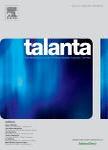版权所有:内蒙古大学图书馆 技术提供:维普资讯• 智图
内蒙古自治区呼和浩特市赛罕区大学西街235号 邮编: 010021

作者机构:Nanjing Forestry Univ Coll Light Ind & Food Engn Nanjing 210037 Peoples R China
出 版 物:《TALANTA》 (Talanta)
年 卷 期:2025年第284卷
页 面:127244页
核心收录:
学科分类:081704[工学-应用化学] 07[理学] 08[工学] 0817[工学-化学工程与技术] 070302[理学-分析化学] 0703[理学-化学]
基 金:Natural Science Foun-dation of Jiangsu [BK20200764]
主 题:Metal-organic frameworks Nanozyme Sensor array Biogenic amines Histamine
摘 要:Biogenic amines (BAs) are hazardous substances found in fishery products that are closely associated with fish spoilage and threaten food safety. Traditional chromatographic methods for detecting BAs are expensive, complex, and time-consuming. In this study, we developed a nanozyme-based sensor array to efficiently discriminate between four types of BAs and sensitively detect histamine. Copper-, cerium-, and manganese-based metal-organic frameworks with excellent peroxidase-like activities were employed as sensor elements. Because the catalytic activities of metal-organic frameworks could be modified by different BAs to varying degrees, the sensor array could generate a distinct colorimetric response pattern (fingerprint) for each BA. Based on this principle, the sensor array accurately discriminated BAs over a wide concentration range (10-1000 mu M). Histamine could be distinguished down to 1 mu M and detected with a detection limit of 4.28 mu M within 20 min. In addition, mixtures of BAs, target BAs, interfering substances, and BAs in fishery product samples were well discriminated. Furthermore, our sensor array could also effectively distinguish the freshness of fish samples. This work might offer a useful strategy for the discrimination and detection of BAs and could positively contribute to food safety and public health.